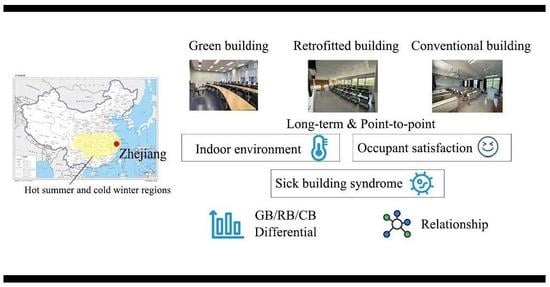Field Measurements and Analysis of Indoor Environment, Occupant Satisfaction, and Sick Building Syndrome in University Buildings in Hot Summer and Cold Winter Regions in China
Abstract
:1. Introduction
2. Methods
2.1. Case Study Context
2.2. Data Collection
2.2.1. Indoor Environmental Measurements
| Parameter | Transition | Winter | The Reference Standard |
|---|---|---|---|
| Air temperature | 21–28 °C | 18–24 °C | GB 50736-2012 [32] |
| Relative humidity | - | ≥30% | GB 50736-2012 [32] |
| CO2 concentration | ≤1000 ppm | GB/T 18883-2022 [33] | |
| PM2.5 concentration | ≤37.5 µg·m−3 | T/ASC 02-2021 [34] | |
| Illuminance | ≥300 lux | GB 50034-2013 [35] | |
| Acoustic | ≤45 dB (LAeq,T) | GB 55016-2021 [36] | |
2.2.2. Questionnaire Survey
2.2.3. IEQ Evaluation Method
2.3. Statistical Analysis
3. Results
3.1. Long-Term Indoor Environment
3.1.1. Thermal Environment
- Air Temperature
- Relative Humidity
3.1.2. Indoor Air Quality
- CO2 Concentration
- PM2.5 Concentration
3.1.3. Visual Environment
3.1.4. Acoustic Environment
3.1.5. Compliance Rate of the Indoor Environment
3.2. Occupant Satisfaction
3.2.1. Thermal Satisfaction
- Temperature Satisfaction
- Humidity Satisfaction
3.2.2. Visual Satisfaction
3.2.3. Acoustic Satisfaction
3.2.4. Air Quality Satisfaction
3.2.5. Overall Environment Satisfaction
3.2.6. Satisfaction with Building Services
3.3. SBS Symptoms
3.4. The Relationship between Different Aspects
3.4.1. Relationship between the Indoor Environment and the Occurrence of SBS Symptoms
3.4.2. Relationship between the Indoor Environment and Learning Efficiency
3.4.3. Relationship between the Occurrence of SBS Symptoms and Learning Efficiency
3.4.4. Relationship between Gender, Seat Location, and the Occurrence of SBS Symptoms
3.5. Comparison of Building Performance in Three Buildings
4. Discussion
4.1. Comparison of IEQ Weights in Different Types of Buildings
4.2. Recommendations for University Teaching Building Design
4.3. Limitations and Future Studies
5. Conclusions
Author Contributions
Funding
Institutional Review Board Statement
Informed Consent Statement
Data Availability Statement
Acknowledgments
Conflicts of Interest
References
- Ministry of Education of the People’s Republic of China. Overview of China’s Education. The Development of China’s Education in 2020. Available online: http://www.moe.gov.cn/jyb_sjzl/s5990/202111/t20211115_579974.html (accessed on 16 May 2022).
- Li, Y.; Ge, Y.; Wu, C.; Guan, D.; Liu, J.; Wang, F. Assessment of culturable airborne bacteria of indoor environments in classrooms, dormitories and dining hall at university: A case study in China. Aerobiologia 2020, 36, 313–324. [Google Scholar] [CrossRef] [PubMed]
- Gou, Z.; Prasad, D.; Siu-Yu Lau, S. Are green buildings more satisfactory and comfortable? Habitat Int. 2013, 39, 156–161. [Google Scholar] [CrossRef]
- Xuan, X. Study of indoor environmental quality and occupant overall comfort and productivity in LEED- and non-LEED–certified healthcare settings. Indoor Built Environ. 2016, 27, 544–560. [Google Scholar] [CrossRef]
- Newsham, G.R.; Birt, B.J.; Arsenault, C.; Thompson, A.J.L.; Veitch, J.A.; Mancini, S.; Galasiu, A.D.; Gover, B.N.; Macdonald, I.A.; Burns, G.J. Do ‘green’ buildings have better indoor environments? New evidence. Build. Res. Inf. 2013, 41, 415–434. [Google Scholar] [CrossRef]
- Pastore, L.; Andersen, M. Building energy certification versus user satisfaction with the indoor environment: Findings from a multi-site post-occupancy evaluation (POE) in Switzerland. Build. Environ. 2019, 150, 60–74. [Google Scholar] [CrossRef]
- Elnaklah, R.; Walker, I.; Natarajan, S. Moving to a green building: Indoor environment quality, thermal comfort and health. Build. Environ. 2021, 191, 107592. [Google Scholar] [CrossRef]
- Lee, J.-Y.; Wargocki, P.; Chan, Y.-H.; Chen, L.; Tham, K.-W. How does indoor environmental quality in green refurbished office buildings compare with the one in new certified buildings? Build. Environ. 2020, 171, 106677. [Google Scholar] [CrossRef]
- Khoshbakht, M.; Gou, Z.; Lu, Y.; Xie, X.; Zhang, J. Are green buildings more satisfactory? A review of global evidence. Habitat Int. 2018, 74, 57–65. [Google Scholar] [CrossRef]
- Mujan, I.; Anđelković, A.S.; Munćan, V.; Kljajić, M.; Ružić, D. Influence of indoor environmental quality on human health and productivity—A review. J. Clean. Prod. 2019, 217, 646–657. [Google Scholar] [CrossRef]
- Oldham, E.; Kim, H. IEQ Field Investigation in High-Performance, Urban Elementary Schools. Atmosphere 2020, 11, 81. [Google Scholar] [CrossRef]
- Kapoor, N.R.; Kumar, A.; Alam, T.; Kumar, A.; Kulkarni, K.S.; Blecich, P. A Review on Indoor Environment Quality of Indian School Classrooms. Sustainability 2021, 13, 11855. [Google Scholar] [CrossRef]
- Geng, Y.; Ji, W.; Lin, B.; Zhu, Y. The impact of thermal environment on occupant IEQ perception and productivity. Build. Environ. 2017, 121, 158–167. [Google Scholar] [CrossRef]
- Sadrizadeh, S.; Yao, R.; Yuan, F.; Awbi, H.; Bahnfleth, W.; Bi, Y.; Cao, G.; Croitoru, C.; de Dear, R.; Haghighat, F.; et al. Indoor air quality and health in schools: A critical review for developing the roadmap for the future school environment. J. Build. Eng. 2022, 57, 104908. [Google Scholar] [CrossRef]
- Korsavi, S.S.; Montazami, A.; Mumovic, D. The impact of indoor environment quality (IEQ) on school children’s overall comfort in the UK; a regression approach. Build. Environ. 2020, 185, 107309. [Google Scholar] [CrossRef]
- Jia, L.-R.; Han, J.; Chen, X.; Li, Q.-Y.; Lee, C.-C.; Fung, Y.-H. Interaction between Thermal Comfort, Indoor Air Quality and Ventilation Energy Consumption of Educational Buildings: A Comprehensive Review. Buildings 2021, 11, 591. [Google Scholar] [CrossRef]
- Korsavi, S.S.; Jones, R.V.; Fuertes, A. Operations on windows and external doors in UK primary schools and their effects on indoor environmental quality. Build. Environ. 2022, 207, 108416. [Google Scholar] [CrossRef]
- Allen, J.G.; MacNaughton, P.; Satish, U.; Santanam, S.; Vallarino, J.; Spengler, J.D. Associations of Cognitive Function Scores with Carbon Dioxide, Ventilation, and Volatile Organic Compound Exposures in Office Workers: A Controlled Exposure Study of Green and Conventional Office Environments. Env. Health Perspect. 2016, 124, 805–812. [Google Scholar] [CrossRef] [Green Version]
- Wang, D.; Xu, Y.; Liu, Y.; Wang, Y.; Jiang, J.; Wang, X.; Liu, J. Experimental investigation of the effect of indoor air temperature on students’ learning performance under the summer conditions in China. Build. Environ. 2018, 140, 140–152. [Google Scholar] [CrossRef]
- Wu, J.; Weng, J.; Xia, B.; Zhao, Y.; Song, Q. The Synergistic Effect of PM2.5 and CO2 Concentrations on Occupant Satisfaction and Work Productivity in a Meeting Room. Int. J. Env. Res. Public Health 2021, 18, 4109. [Google Scholar] [CrossRef]
- Nordb, A.K.J.L.J.; Bovaird, J. Identifying the K-12 classrooms’ indoor air quality factors that affect student academic performance. Sci. Total Environ. 2021, 786, 147498. [Google Scholar] [CrossRef]
- Palumbo, J.R.; Lin, S.; Lin, Z.; Neamtiu, I.A.; Zhang, W.; Csobod, E.; Gurzau, E.S. Assessing associations between indoor environment and health symptoms in Romanian school children: An analysis of data from the SINPHONIE project. Environ. Sci. Pollut. Res. Int. 2018, 25, 9186–9193. [Google Scholar] [CrossRef]
- MacNaughton, P.; Spengler, J.; Vallarino, J.; Santanam, S.; Satish, U.; Allen, J. Environmental Perceptions and Health before and after Relocation to a Green Building. Build. Environ. 2016, 104, 138–144. [Google Scholar] [CrossRef] [Green Version]
- Demir Yıldız, C. A Management Factor at Sick Building Syndrome: Are Old or New School Buildings Sick? Educ. Policy Anal. Strateg. Res. 2020, 15, 209–231. [Google Scholar] [CrossRef]
- Sarkhosh, M.; Najafpoor, A.A.; Alidadi, H.; Shamsara, J.; Amiri, H.; Andrea, T.; Kariminejad, F. Indoor Air Quality associations with sick building syndrome: An application of decision tree technology. Build. Environ. 2021, 188, 107446. [Google Scholar] [CrossRef]
- Amouei, A.; Aghalari, Z.; Zarei, A.; Afsharnia, M.; Geraili, Z.; Qasemi, M. Evaluating the relationships between air pollution and environmental parameters with sick building syndrome in schools of Northern Iran. Indoor Built Environ. 2019, 28, 1422–1430. [Google Scholar] [CrossRef]
- Abdel Fattah, A. Qaraman; Maher Elbayoumi; Khadoura, K.J. Indoor environmental quality and sick building syndromes in naturally ventilated educational laboratories: Case study from Israa university-Gaza. J. Glob. Ecol. Environ. 2021, 11, 37–48. [Google Scholar]
- Hou, J.; Sun, Y.; Dai, X.; Liu, J.; Shen, X.; Tan, H.; Yin, H.; Huang, K.; Gao, Y.; Lai, D.; et al. Associations of indoor carbon dioxide concentrations, air temperature, and humidity with perceived air quality and sick building syndrome symptoms in Chinese homes. Indoor Air 2021, 31, 1018–1028. [Google Scholar] [CrossRef]
- Ketema, R.M.; Araki, A.; Ait Bamai, Y.; Saito, T.; Kishi, R. Lifestyle behaviors and home and school environment in association with sick building syndrome among elementary school children: A cross-sectional study. Environ. Health Prev. Med. 2020, 25, 28. [Google Scholar] [CrossRef]
- Xie, R.; Xu, Y.; Yang, J.; Zhang, S. Indoor air quality investigation of a badminton hall in humid season through objective and subjective approaches. Sci. Total. Environ. 2021, 771, 145390. [Google Scholar] [CrossRef]
- Cândido, C.; de Dear, R.; Thomas, L.; Kim, J.; Parkinson, T. Introducing BOSSA: The Building Occupants Survey System Australia; Ecolibrium: Melbourne, Australia, 2013. [Google Scholar]
- GB 50736-2012; Design Code for Heating and Air Conditioning of Civil Buildings. Ministry of Housing and Urban-Rural Development of the People’s Republic of China, General Administration of Quality Supervision: Beijing, China, 2012.
- GB/T18883-2022; Standards for Indoor Air Quality. State Administration for Market Regulation, National Standardization Management Committee: Beijing, China, 2022.
- T/ASC 02-2021; Assessment Standard for Healthy Building. The Architectural Society of China: Beijing, China, 2021.
- GB 50034-2013; Standard for Lighting Design of Buildings. Ministry of Housing and Urban-Rural Development of the People’s Republic of China: Beijing, China, 2013.
- GB 55016-2021; State Administration for Market Regulation. General Code for Building Environment. Ministry of Housing and Urban-Rural Development of the People’s Republic of China: Beijing, China, 2021.
- Joshi, A.; Kale, S.; Chandel, S.; Pal, D. Likert Scale: Explored and Explained. Br. J. Appl. Sci. Technol. 2015, 7, 396–403. [Google Scholar] [CrossRef]
- Zagreus, L.; Huizenga, C.; Arens, E.; Lehrer, D. Listening to the occupants: A Web-based indoor environmental quality survey. Indoor Air 2004, 14, 65–74. [Google Scholar] [CrossRef] [PubMed]
- Tahsildoost, M.; Zomorodian, Z.S. Indoor environment quality assessment in classrooms: An integrated approach. J. Build. Phys. 2018, 42, 336–362. [Google Scholar] [CrossRef]
- Ghita, S.A.; Catalina, T. Energy efficiency versus indoor environmental quality in different Romanian countryside schools. Energy Build. 2015, 92, 140–154. [Google Scholar] [CrossRef]
- Wei, W.; Wargocki, P.; Zirngibl, J.; Bendžalová, J.; Mandin, C. Review of parameters used to assess the quality of the indoor environment in Green Building certification schemes for offices and hotels. Energy Build. 2020, 209, 109683. [Google Scholar] [CrossRef]
- Frontczak, M.; Wargocki, P. Literature survey on how different factors influence human comfort in indoor environments. Build. Environ. 2011, 46, 922–937. [Google Scholar] [CrossRef]
- Cao, B.; Ouyang, Q.; Zhu, Y.X.; Huang, L.; Hu, H.B.; Deng, G.F. Development of a multivariate regression model for overall satisfaction in public buildings based on field studies in Beijing and Shanghai. Build. Environ. 2012, 47, 394–399. [Google Scholar] [CrossRef]
- Catalina, T.; Iordache, V. IEQ assessment on schools in the design stage. Build. Environ. 2012, 49, 129–140. [Google Scholar] [CrossRef]
- Piasecki, M.; Kostyrko, K.; Pykacz, S. Indoor environmental quality assessment: Part 1: Choice of the indoor environmental quality sub-component models. J. Build. Phys. 2017, 41, 264–289. [Google Scholar] [CrossRef]
- Buratti, C.; Belloni, E.; Merli, F.; Ricciardi, P. A new index combining thermal, acoustic, and visual comfort of moderate environments in temperate climates. Build. Environ. 2018, 139, 27–37. [Google Scholar] [CrossRef]
- Piasecki, M.; Kostyrko, K.B. Indoor environmental quality assessment, part 2: Model reliability analysis. J. Build. Phys. 2018, 42, 288–315. [Google Scholar] [CrossRef]
- Fassio, F.; Fanchiotti, A.; Vollaro, R.D. Linear, Non-Linear and Alternative Algorithms in the Correlation of IEQ Factors with Global Comfort: A Case Study. Sustainability 2014, 6, 8113–8127. [Google Scholar] [CrossRef]
- Li, K.W.; Shen, J.D.; Zhang, X.; Chen, L.H.; White, S.; Yan, M.M.; Han, L.X.; Yang, W.; Wang, X.H.; Azzi, M. Variations and characteristics of particulate matter, black carbon and volatile organic compounds in primary school classrooms. J. Clean. Prod. 2019, 252, 119804. [Google Scholar] [CrossRef]
- Tang, H.; Ding, Y.; Singer, B.C. Post-occupancy evaluation of indoor environmental quality in ten nonresidential buildings in Chongqing, China. J. Build. Eng. 2020, 32, 101649. [Google Scholar] [CrossRef]
- Baloch, R.M.; Maesano, C.N.; Christoffersen, J.; Banerjee, S.; Gabriel, M.; Csobod, E.; de Oliveira Fernandes, E.; Annesi-Maesano, I.; SINPHONIE Study group. Indoor air pollution, physical and comfort parameters related to schoolchildren’s health: Data from the European SINPHONIE study. Sci. Total. Environ. 2020, 739, 139870. [Google Scholar] [CrossRef]
- Hu, J.H.; He, Y.D.; Hao, X.L.; Li, N.P.; Su, Y.; Qu, H.D. Optimal temperature ranges considering gender differences in thermal comfort, work performance, and sick building syndrome: A winter field study in university classrooms. Energy Build. 2022, 254, 111554. [Google Scholar] [CrossRef]
- Babaoglu, U.T.; Sezgin, F.M.; Yag, F. Sick building symptoms among hospital workers associated with indoor air quality and personal factors. Indoor Built Environ. 2020, 29, 645–655. [Google Scholar] [CrossRef]
- Wargocki, P.; Porras-Salazar, J.A.; Contreras-Espinoza, S.; Bahnfleth, W. The relationships between classroom air quality and children’s performance in school. Build. Environ. 2020, 173, 106749. [Google Scholar] [CrossRef]
- Ru, T.; Smolders, K.; Chen, Q.; Zhou, G.; Kort, Y.d. Diurnal effects of illuminance on performance:Exploring the moderating role of cognitive domain and task difficulty. Light. Res. Technol. 2021, 53, 727–747. [Google Scholar] [CrossRef]

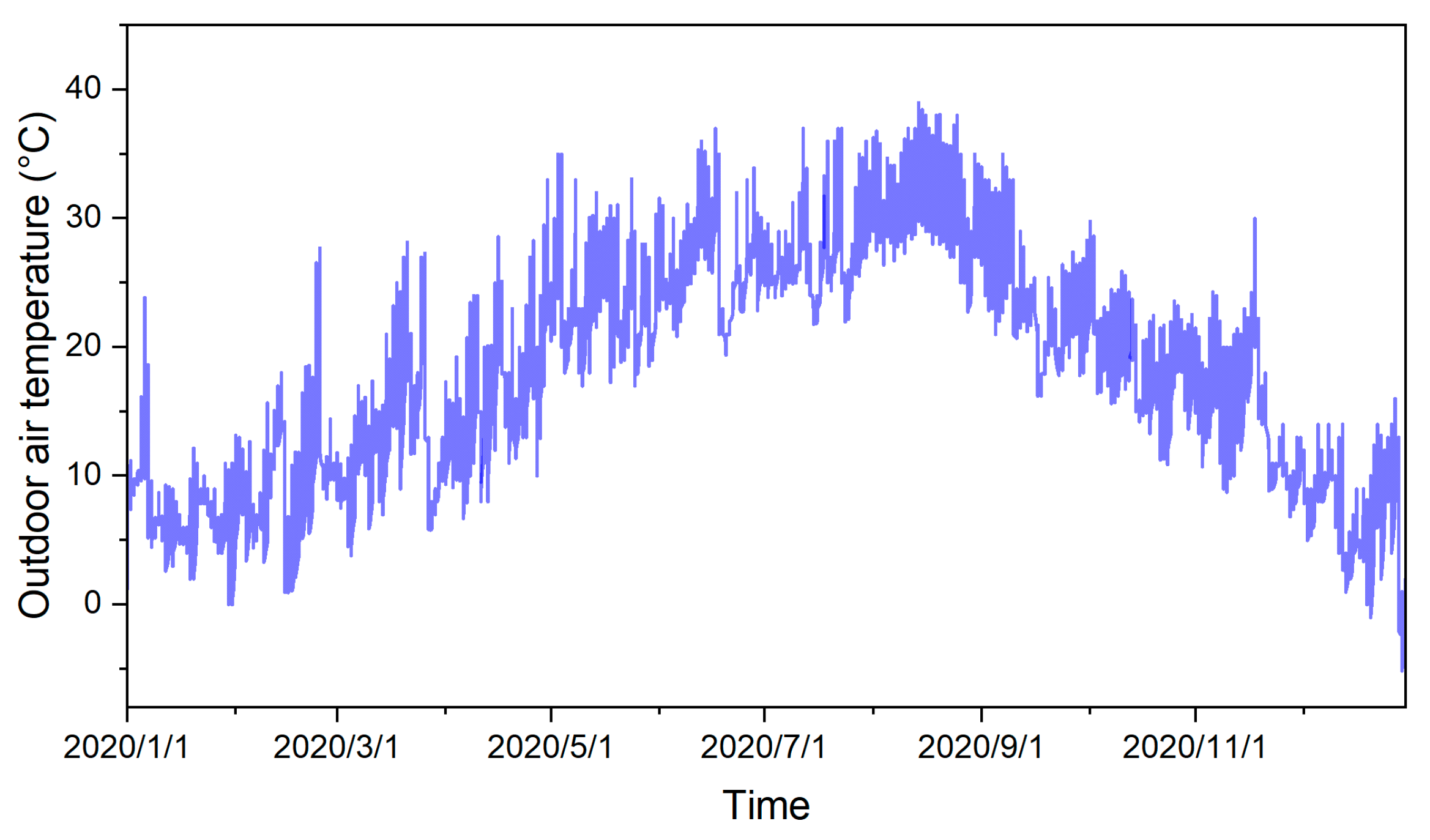
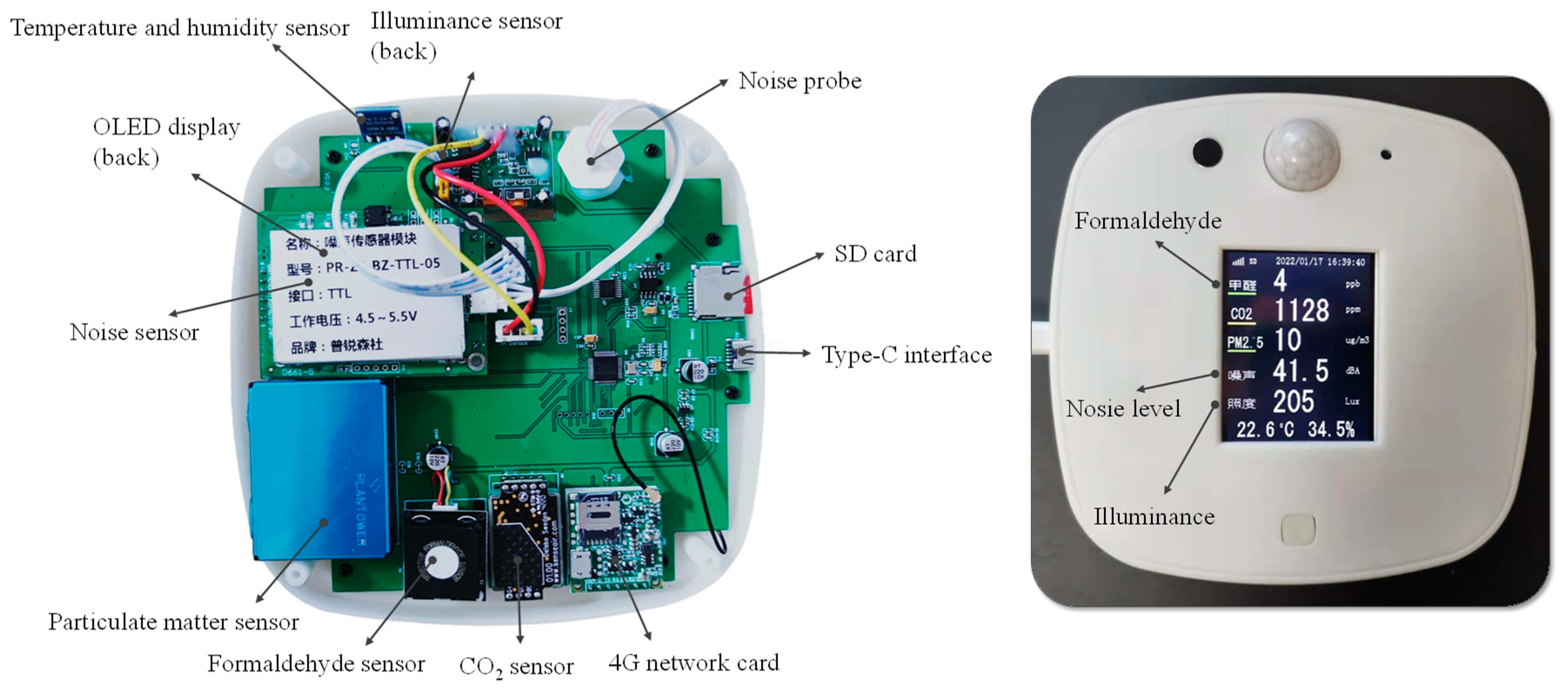
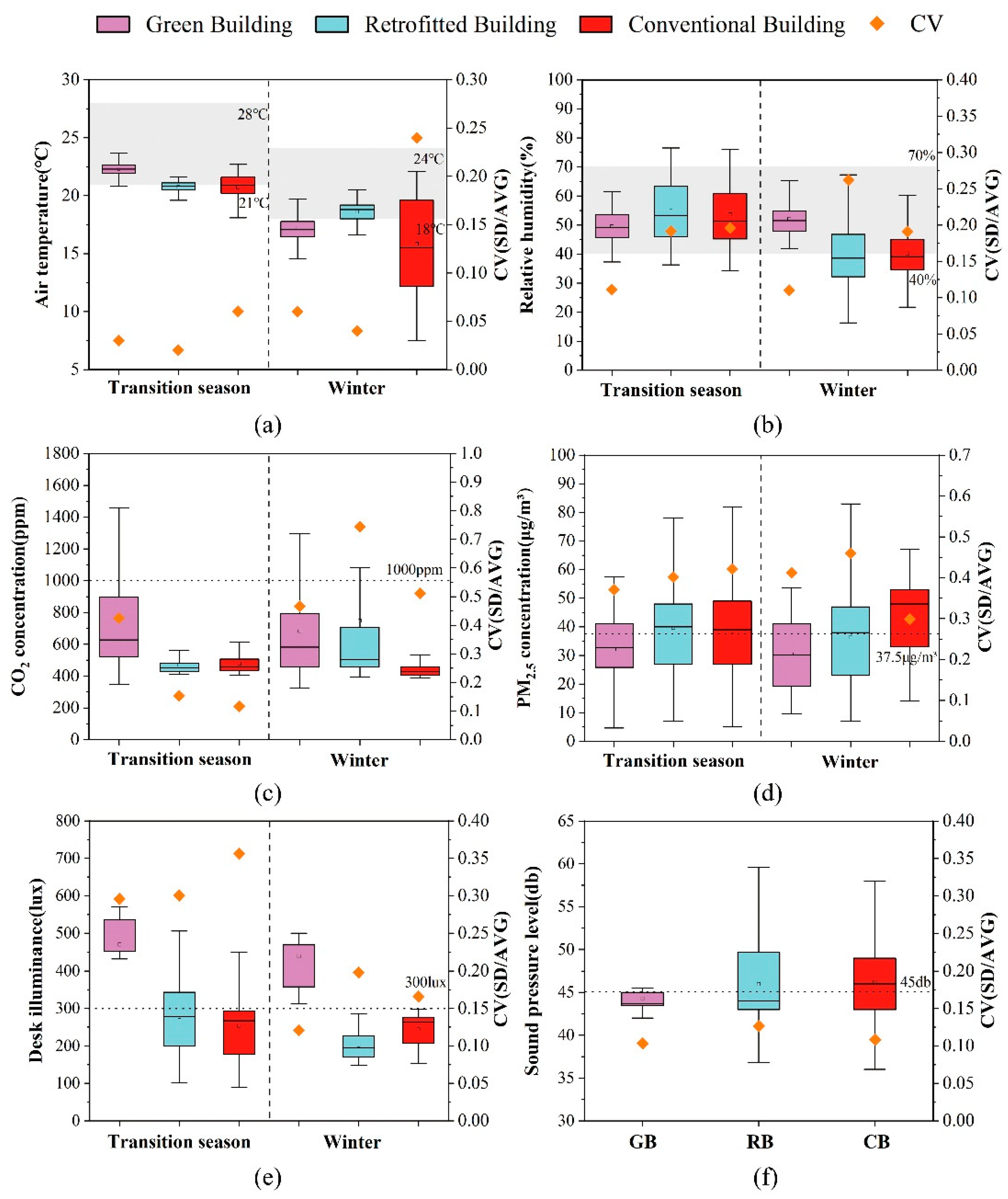
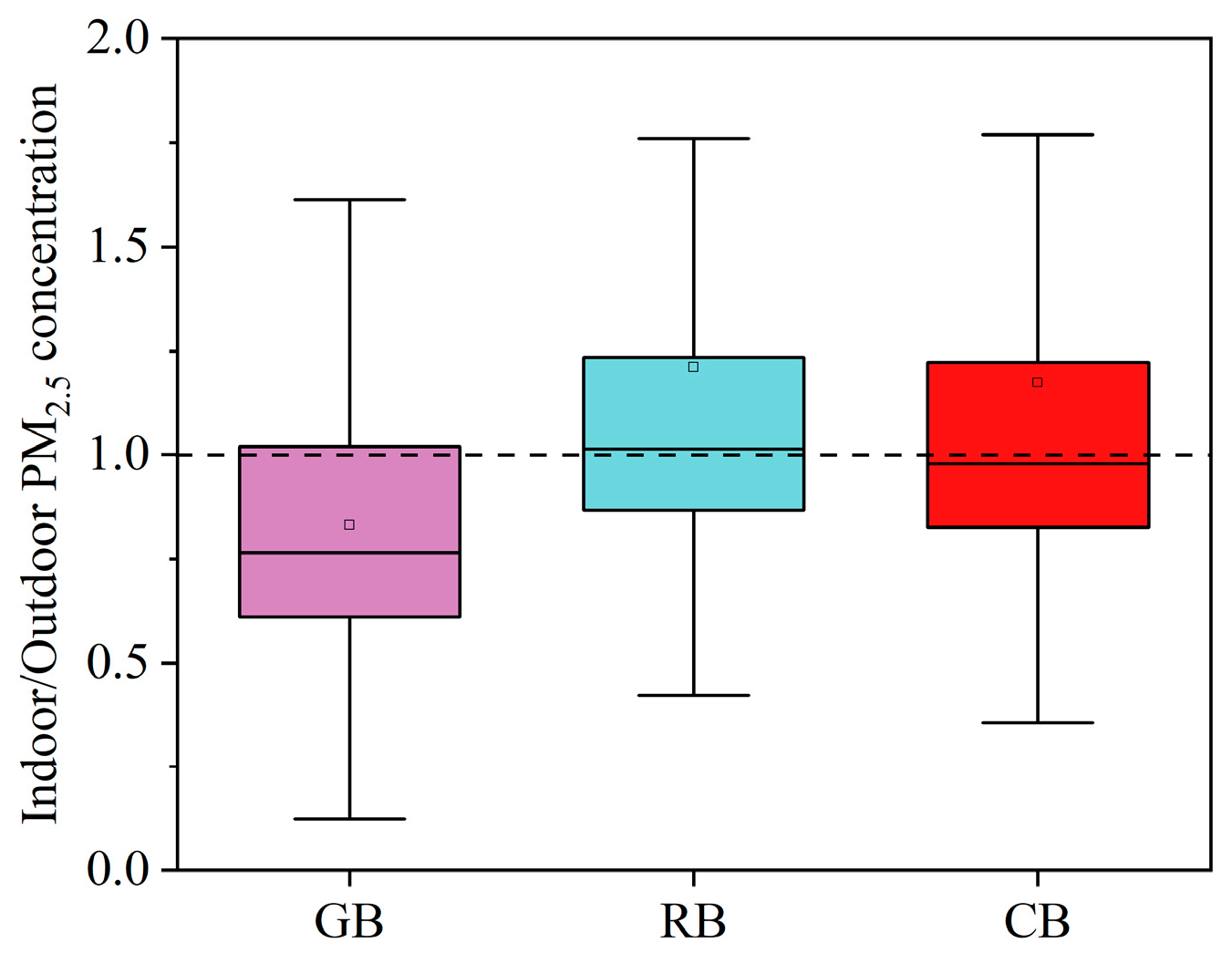


| Year Built or Retrofitted | Ventilation Mode | Gross Floor Area | Air Condition System | Number of Floors | Selected Classrooms | |
|---|---|---|---|---|---|---|
| Green Building (GB) | 2017 | Mechanical | 9297 m2 | Central | 5 | 12.6 × 7.2 m (South, 2nd floor) 7.2 × 8.4 m (East, 4th floor) 7.2 × 8.4 m (West, 3rd floor) 16.8 × 10.2 (North, 4th floor) |
| Retrofitted Building (RB) | 2012 | Mixed | 3840 m2 | Spilt | 6 | 9.2 × 5.6 m (North, 1st floor) 9.2 × 5.6 m (South, 5th floor) |
| Conventional Building (CB) | 1999 | Natural | 2904 m2 | Spilt | 6 | 10.0 × 6.5 m (North, 2nd floor) 10.0 × 6.5 m (North, 3rd floor) 10.0 × 6.5 m (North, 4th floor) 10.0 × 6.5 m (North, 5th floor) |
| Thermal | Air Quality | Visual | Acoustic | |
|---|---|---|---|---|
| Parameter | Air temperature and relative humidity | CO2 and PM2.5 concentration | Desktop illuminance | Sound pressure level |
| Location | One metre around the respondents | Desktop | One metre around the respondents at a height of 1.5 m | |
| Long-term | Transition season, winter at least two weeks; 5-min interval | - | Continuous 20 min | |
| Point-to-point | 3-min average | The average of three measuring points | 3-min average | |
| Parameter | Sensor Model | Accuracy |
|---|---|---|
| Air temperature | SENSIRON SHT30-DIS | ±0.1 °C |
| Relative humidity | SENSIRON SHT30-DIS | ±1.5% |
| CO2 concentration | SenseAir S8 LP | ±40 ppm |
| PM2.5 concentration | PMS70003 | ±10% |
| Illuminance | ROHM BH1750FVI | ±4% |
| Sound pressure level | PR-ZS-BZ | ±0.5 dB |
| Content | |
|---|---|
| Background information | Gender, age, and location |
| Satisfaction with an indoor environment | Temperature, humidity, visual, air quality and acoustics, learning efficiency, interior space design, and building service performance |
| Self-reported SBS symptoms | Dry, itchy, or irritated eyes Dry, itchy, runny, or bleeding nose Sore throat or dry tongue Tightness, chest pain Asthma, dry cough, tracheitis Flushed, dry, or itchy skin Weakness, lethargy Fidgety, excitable, anxious Dizziness or headache Nausea, loss of appetite, indigestion Distracted or error-prone Other symptoms |
| Parameter | GB | RB | CB | |||
|---|---|---|---|---|---|---|
| Season | Transition | Winter | Transition | Winter | Transition | Winter |
| Air temperature | 98.7% | 20.6% | 39.8% | 79.8% | 47.8% | 36.7% |
| Relative humidity | 96.6% | 100% | 84.0% | 83.4% | 84.7% | 93.4% |
| CO2 concentration | 78.5% | 85.4% | 100% | 82.3% | 100% | 98.1% |
| PM2.5 concentration | 65.3% | 62.8% | 44.6% | 48.6% | 48.6% | 38.0% |
| Illuminance | 100% | 100% | 40.4% | 0% | 21.6% | 0% |
| Sound pressure level | 79.6% | 42.4% | 58.7% | |||
| Total | GB | RB | CB | |
|---|---|---|---|---|
| Gender | ||||
| Male | 163 | 53/82% | 61/41% | 49/23% |
| Female | 236 | 12/19% | 89/59% | 135/77% |
| Age (years) | ||||
| <18 | 6 | 2/3% | 0/0 | 4/2% |
| 18–22 | 391 | 61/94% | 150/100% | 180/98% |
| >22 | 2 | 2/3% | 0/0 | 0/0 |
| Air Temperature | Relative Humidity | CO2 Concentration | PM2.5 Concentration | Illuminance | Sound Pressure Level | |
|---|---|---|---|---|---|---|
| Dry, itchy, or irritated eyes | 0.025 | 0.092 | 0.059 | −0.045 | −0.001 | −0.044 |
| Dry, itchy, runny, or bleeding nose | 0.104 * | −0.111 * | −0.036 | −0.021 | 0.046 | 0.000 |
| Sore throat or dry tongue | 0.123 * | −0.072 | −0.066 | −0.100 * | 0.081 | 0.007 |
| Tightness, chest pain | 0.035 | 0.014 | −0.039 | −0.045 | 0.035 | −0.015 |
| Asthma, dry cough, tracheitis | −0.106 * | −0.069 | −0.106 * | 0.097 | −0.071 | 0.017 |
| Flushed, dry, or itchy skin | −0.106 * | −0.074 | −0.118 * | 0.099 | −0.086 | −0.002 |
| Weakness, lethargy | 0.085 | 0.042 | 0.057 | −0.052 | −0.017 | 0.027 |
| Fidgety, excitable, anxious | 0.015 | −0.030 | −0.061 | −0.011 | 0.010 | 0.015 |
| Dizziness or headache | 0.028 | −0.069 | −0.011 | −0.060 | 0.098 | −0.020 |
| Nausea, loss of appetite, indigestion | 0.085 | 0.026 | 0.008 | −0.086 | 0.004 | 0.017 |
| Distracted or error-prone | −0.027 | −0.015 | −0.065 | −0.087 | 0.055 | −0.005 |
| Other symptoms | 0.015 | 0.014 | 0.010 | −0.016 | −0.062 | −0.024 |
| Air Temperature | Relative Humidity | CO2 Concentration | PM2.5 Concentration | Illuminance | Sound Pressure Level | |
|---|---|---|---|---|---|---|
| Learning efficiency | 0.006 | −0.046 | −0.128 * | 0.16 | 0.148 * | −0.031 |
| Learning Efficiency | |
|---|---|
| Dry, itchy, or irritated eyes | −0.110 * |
| Dry, itchy, runny, or bleeding nose | −0.141 ** |
| Sore throat or dry tongue | −0.105 * |
| Tightness, chest pain | 0.026 |
| Asthma, dry cough, tracheitis | −0.119 * |
| Flushed, dry, or itchy skin | −0.111 * |
| Weakness, lethargy | −0.169 ** |
| Fidgety, excitable, anxious | −0.105 * |
| Dizziness or headache | 0.006 |
| Nausea, loss of appetite, indigestion | 0.043 |
| Distracted or error-prone | −0.087 |
| Other symptoms | −0.095 |
| Parameter | Unstandardised Coefficients | Standardised Coefficient | t | Sig. | 95% Confidence Interval for B | ||
|---|---|---|---|---|---|---|---|
| B | Standard Error | Lower Limit | Upper Limit | ||||
| (constant) | 1.126 | 0.224 | 5.029 | 0.000 | 0.686 | 1.567 | |
| Temperature satisfaction | 0.247 | 0.047 | 0.285 | 5.241 | 0.000 | 0.155 | 0.340 |
| Humidity satisfaction | 0.052 | 0.044 | 0.061 | 1.199 | 0.231 | −0.033 | 0.138 |
| Air quality satisfaction | 0.103 | 0.044 | 0.110 | 2.341 | 0.020 | 0.016 | 0.189 |
| Visual satisfaction | 0.134 | 0.043 | 0.152 | 3.122 | 0.002 | −0.050 | 0.218 |
| Acoustic satisfaction | 0.265 | 0.059 | 0.248 | 4.475 | 0.000 | 0.148 | 0.381 |
| Temperature | Humidity | Air Quality | Visual Environment | Acoustic Environment |
|---|---|---|---|---|
| wT | - | wAQ | wV | wAC |
| 0.36 | - | 0.14 | 0.19 | 0.31 |
| GB | RB | CB | |
|---|---|---|---|
| Compliance rate |  | ||
| IEQoverall | 75.4 | 53.5 | 40.3 |
| IEQT | 59.7 | 59.8 | 42.3 |
| IEQAQ | 73 | 68.9 | 71.2 |
| IEQV | 100 | 20.2 | 10.8 |
| IEQAC | 79.6 | 42.4 | 58.7 |
| Soverall | 5.6 | 4.8 | 5.1 |
| Occurrence of SBS symptoms | 26.2% | 29.3% | 24.5% |
Disclaimer/Publisher’s Note: The statements, opinions and data contained in all publications are solely those of the individual author(s) and contributor(s) and not of MDPI and/or the editor(s). MDPI and/or the editor(s) disclaim responsibility for any injury to people or property resulting from any ideas, methods, instructions or products referred to in the content. |
© 2022 by the authors. Licensee MDPI, Basel, Switzerland. This article is an open access article distributed under the terms and conditions of the Creative Commons Attribution (CC BY) license (https://creativecommons.org/licenses/by/4.0/).
Share and Cite
Weng, J.; Zhang, Y.; Chen, Z.; Ying, X.; Zhu, W.; Sun, Y. Field Measurements and Analysis of Indoor Environment, Occupant Satisfaction, and Sick Building Syndrome in University Buildings in Hot Summer and Cold Winter Regions in China. Int. J. Environ. Res. Public Health 2023, 20, 554. https://doi.org/10.3390/ijerph20010554
Weng J, Zhang Y, Chen Z, Ying X, Zhu W, Sun Y. Field Measurements and Analysis of Indoor Environment, Occupant Satisfaction, and Sick Building Syndrome in University Buildings in Hot Summer and Cold Winter Regions in China. International Journal of Environmental Research and Public Health. 2023; 20(1):554. https://doi.org/10.3390/ijerph20010554
Chicago/Turabian StyleWeng, Jiantao, Yuhan Zhang, Zefeng Chen, Xiaoyu Ying, Wei Zhu, and Yukai Sun. 2023. "Field Measurements and Analysis of Indoor Environment, Occupant Satisfaction, and Sick Building Syndrome in University Buildings in Hot Summer and Cold Winter Regions in China" International Journal of Environmental Research and Public Health 20, no. 1: 554. https://doi.org/10.3390/ijerph20010554




